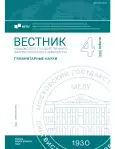The Syntactic Aspect of G. Chaucer’s Language
- 作者: Pavlova E.B.1
-
隶属关系:
- Moscow State Linguistic University
- 期: 编号 4(885) (2024)
- 页面: 96-103
- 栏目: Linguistics
- URL: https://bakhtiniada.ru/2542-2197/article/view/306526
- ID: 306526
如何引用文章
全文:
详细
The article looks into the syntactic peculiarities of G. Chaucer’s language. The order of words in “The Canterbury Tales” possesses considerable positional freedom, but, at the same time, is becoming more fixed. An important feature of Chaucer’s language is the use of compound nominal and verbal (modal and aspective) predicates. The language of “The Canterbury Tales” is characterized by a variety of complex sentences with a wide range of connectives. Special attention is paid to parenthetic expressions as means of establishing anaphoric relations.
作者简介
Elena Pavlova
Moscow State Linguistic University
编辑信件的主要联系方式.
Email: lena.pavlova@live.ru
PhD (Philology), Associate Professor, Assistant Professor at the Department of Grammar and History of the English Language, Faculty of the English language
俄罗斯联邦参考
- Rastorgueva, T.A. (1983) A History of English. Moscow: Vyṡṡaja ṡkola.
- Denison, D. (1993) English Historical Syntax: Verbal Constructions. London: Longman.
- Ivanova, I.P (1973). Xrestomatiya po istorii anglijskogo yazy`ka = A reader in the history of English: A handbook for students of pedagogical faculties. Leningrad: Prosveshhenie. (In Russ.)
- Smirnickij, А.I. (1998) Drevneanglijskij yazy`= The old English language. Moscow: The Publishing House of Moscow State University (In Russ.)
补充文件










